1993 CHEVROLET CORVETTE change wheel
[x] Cancel search: change wheelPage 53 of 370
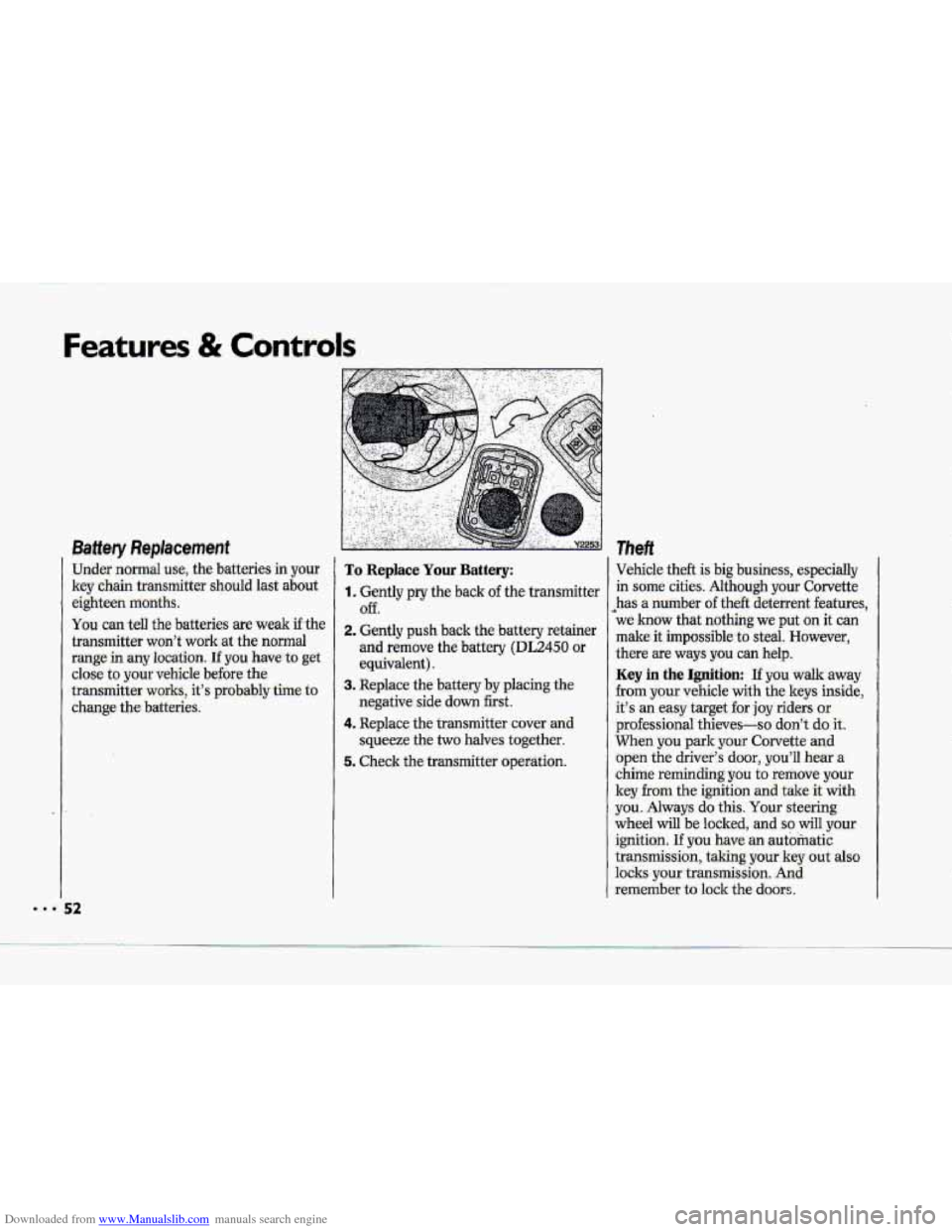
Downloaded from www.Manualslib.com manuals search engine -
Features & Contr ,Is
Baff ery Replacement
Under normal use., the batteries in your
key chain.tramnitter should last about
eighteen months.
You can tell the batteries are weak if the
transmitter won’t workat
the normal
range in any location. If you have to get
close to your vehicle before the
transmitter
works, it’s probably time to
change the batteries.
To Replace Yaw Battery:
1. Gently pry the back of the transmitter
Off.
2. Gently push back the batteryretainer
and remove the battery (DL2450 or
equivalent),
-3. Replace the battery by placing the
negative side
down first.
4. Replace the transmitter covmand
squeeze the
two halves together.
5. Check the transmitter operation.
Theft
Vehicle theft is big business, especially
in
some cities. Although yo.ur Corvette
$as a number
of theft deterrent features,
we how that nothi-ng we put on it can
make it impossible to steal. However,
there are ways you can help.
Key in the Ignition: If you walk awgy
from your vehicle with the keys inside,
it’-s ;an.easy target far joy riders or
professional thieves-so don’t do it.
When you park your Corvette and
open the driver’s door, you’ll heat a
chime reminding you to remove your
key from the ignition and take it with
you.
Always do this. Your steering
wheel will be locked, and so will yo.ur
ignition.
I€ you have-an autbmatic
transmission,,
taking your key out also
locks your transmission-. And
remiember to lock the doors.
Page 77 of 370
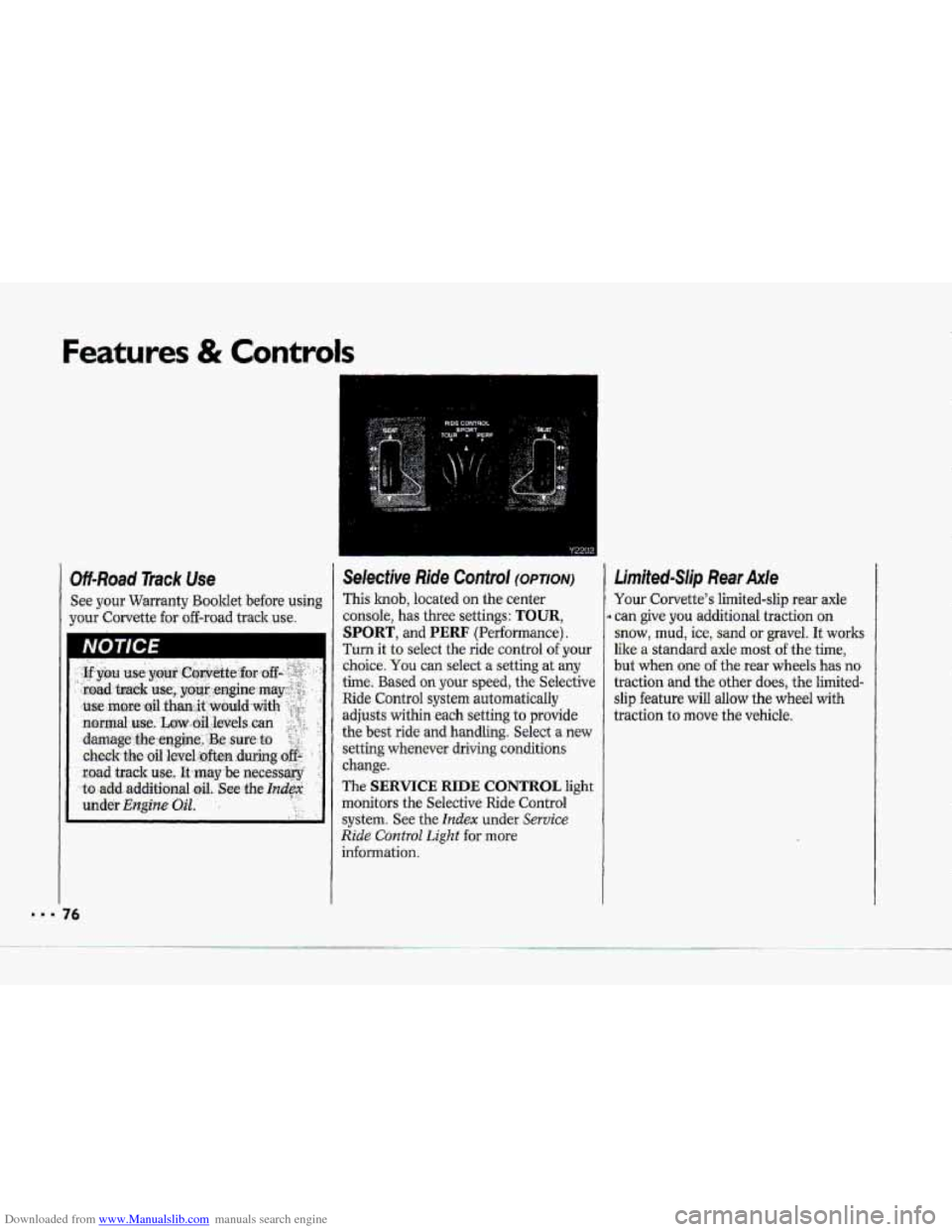
Downloaded from www.Manualslib.com manuals search engine Features & Controls
Of-Road Track Use
See your Warranty Booklet before using
your Corvette
for off-road track use.
NOTICE I
..
Selective. Ride Control (OPTION)
This knob, located on the center
consoIe,
has three settings: TOUR,
SPORT, and PERF (Performance).
Turn it to select the ride control of your
choice. You can select .a setting at my
time. Based your speed, the Selective
Ride Control system automatically
adjusts within each setting to provide
the best ride
and handling. Select a new
setting whenever driving conditions
change.
The
SERVICE RIDE CONTROL light
monitors
the Selective Ride Control
system. See the Index under Service
Ride Control Light €or more
information.
4
Limited-Slip Rear Axle
Your Corvette's limited-slip rear axle
can give
you additional traction on
snow, mud, ice, sand or gravel. It works
like a standard axle most of the time,
but when one of the rear whe.els has no
traction and the other does, the Iirnited-
slip feature will allow the wheel with
traction
to move the vehicle.
76
Page 114 of 370
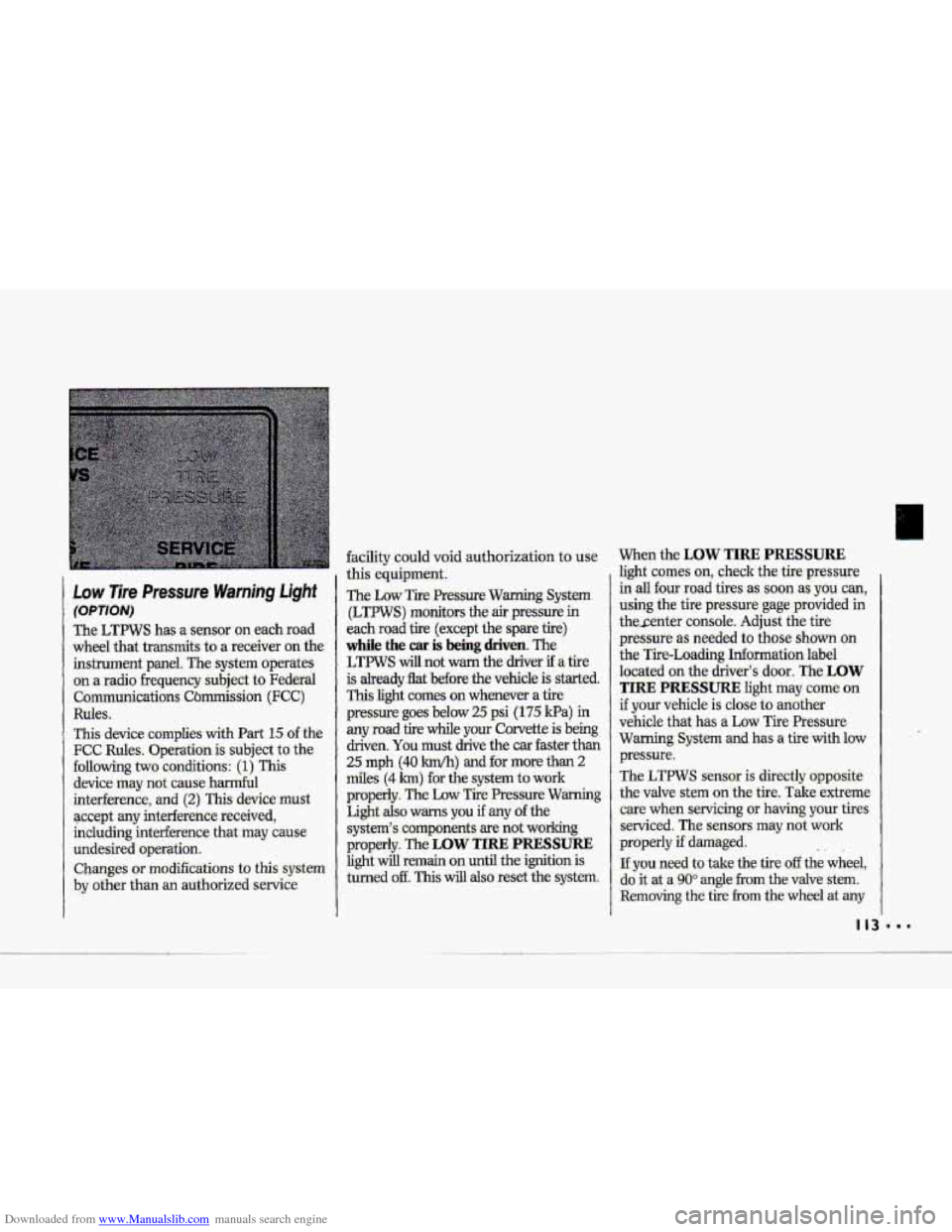
Downloaded from www.Manualslib.com manuals search engine P
Low 7ire Pressure Warning Light
(OPTION)
The LTPWS has a sensor 'on each road
wheel that transmits-to
a receiver on the
instrument panel.
The system operates
on a radio frequency subject
to Federal
Communications Cbmission
(FCC)
Ruks.
This device complies with Part 15 of the
FCC Rules. Operation is subject to the
following
two conditions: (1) This
device may not cause harmful
interhence,
and (2) This device.must
accept
any interhence received,
including interference that-may cause
undesired operation.
Changes or modifications to- this system
by other than an authorized service
facility could void authorization to use
this equipment.
The Low Tre Pressure Warning System
(LTPWS) monitors the
air pressure in
each road tire (except the spare tire)
while the car is being driven. The
LTFWS will not warn the driver if a tire
is
already flat before the vehicle is started.
This light comes on whenever a tire
pressure
goes below 25 psi (I 75 Ha) in
any road tire while your Corvette is being
driven.
You must drive the car faster than
25 mph (40 km/h) and for more than 2
miles (4 h) -for the system to work
properly.
The Low Tire Pressure Warming
Light also warns you if any of the
system's comp.onents-are not working
properly. The
LOW TIRE PRESSURE
light will remain on until the ignition is
turned
off. This will also reset the system.
When the LOW TIRE PRESSURE
fight comes on, check the tire -pressure
.in
all four road tires as soon as you can,
using the
tire pre:ssure gage.provided in
thesenter console. Adjust the tire
pressure as needed to those shown on
the Tire-Loading Information label
10-cated
on the driver's door, The LOW
TIRE PRESSURE light may come on
if your vehicle is close to aaother
vehicle that has
a Low Tire Pressure
Warning System
and has a tire-with low
pressure.
The LTPWS sensor is directly opposite
the valve stem on the tire. Take extreme
care when servicing or
having your tires
serviced. The sensors may not work
properly
if damaged.
If you need to take the tire off the wheel,
do it at a
90" angle from the valve stem.
Removing the tire from the wheel at any
.. 1
Page 175 of 370
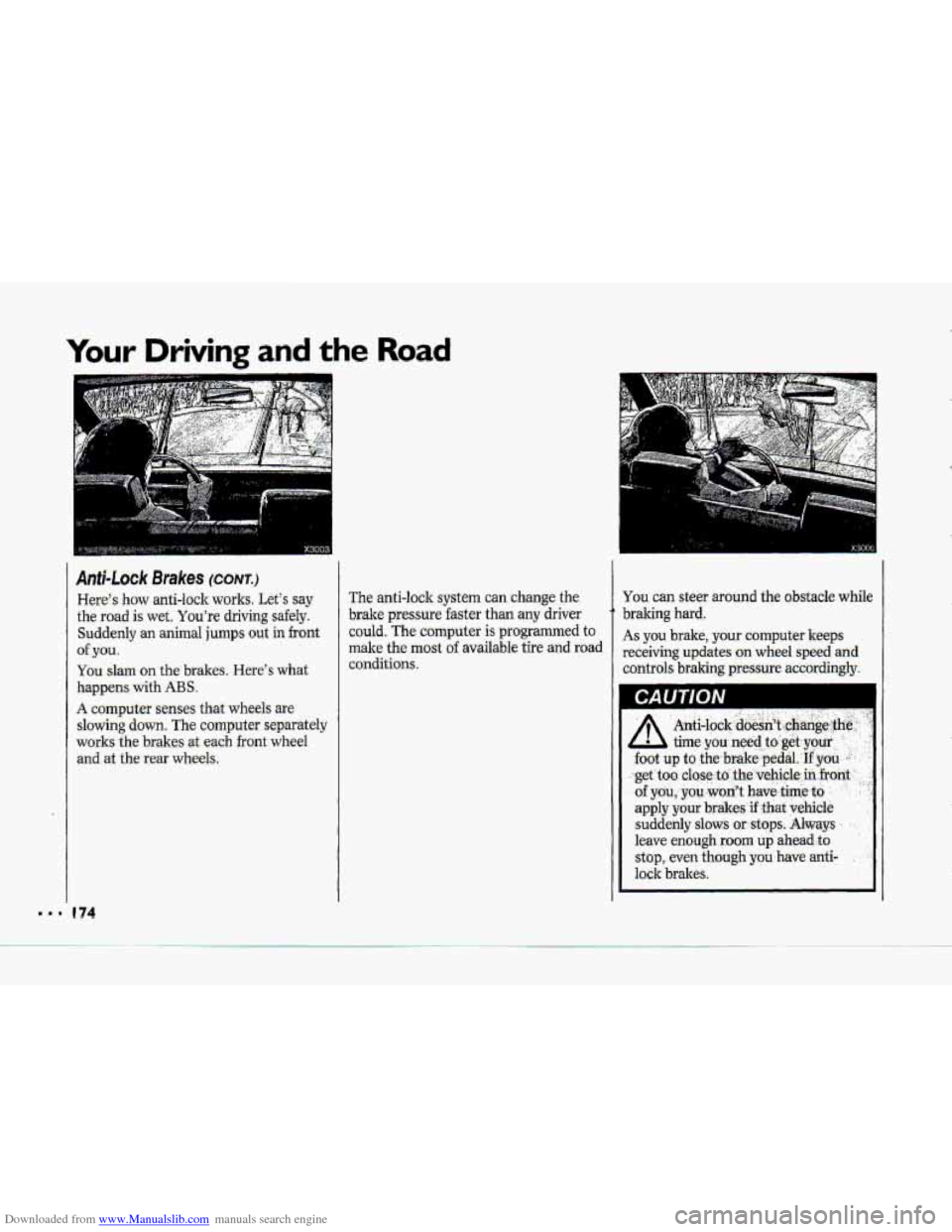
Downloaded from www.Manualslib.com manuals search engine Your Driving and the Road
L.l
Anfi-Lock Brakes (CONT.)
Here's haw anti-lock works. Let's say
the road is wet. You're driving safely.
Suddenly an animal jumps out in front
of ,you.
You slam on the brakes. ,Here's what
happens with ABS .
A computer senses that wheels are
slowing down. The computer separately
works
the brakesat each front wheel
and at the .rear wheels.
e 74
The anti-lock system can change the
brake pressure faster than
any driver
could. The computer
is programmed to
make the most of available tire alid road
conditions.
You can steer around the obstacle while
braking hard.
As you brake, your computer keeps
receiving
updates on wheel speed ad
controls braking pressure accordingly.
CAUTION
Page 180 of 370
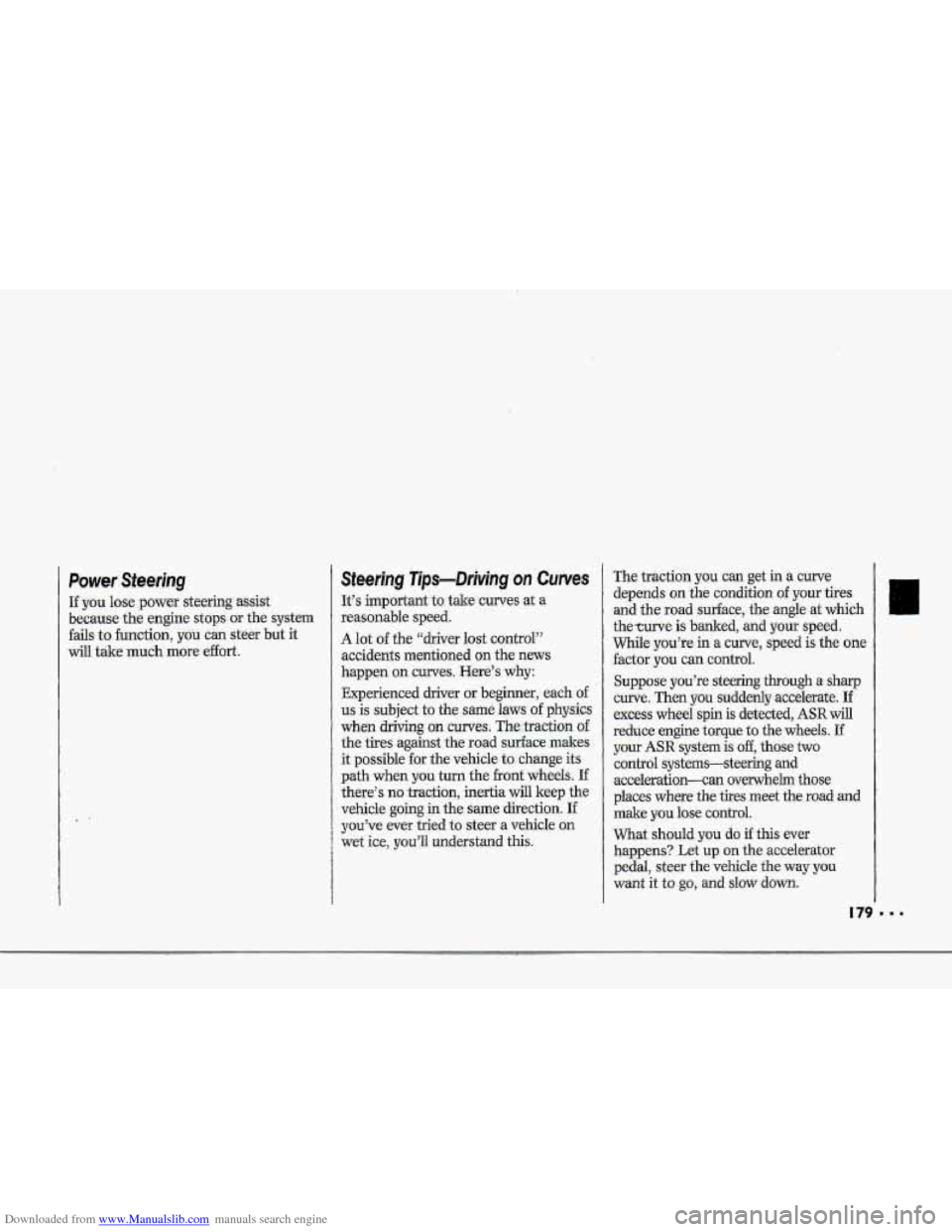
Downloaded from www.Manualslib.com manuals search engine r" i
'4
f
-/_
i
t-
i
Power Steering
If you lose power steering assist
because the engine stops
or the system
fails to function, you c-an steer but it
will take much more effort.
i.
steering Tips-Dtiving on Curves
It's important to tale curves at a
reasonable
speed.
A lot of the "driver lost control"
accidents mentioned
on. the news
happen on .curves. .Here's why:
Experienced driver
or beginner, each of
us is subject to the same laws of physics
when
driving on'curves; The.;traction of
the tixes against the road surface makes
it possible
for the vehicle to change its
path when you turn the front wheels. If
there's no traction, inertia will keep the
vehicle going in the same direction. If
yuu"ve mer tried to steer a vehicle on
wet ice> you:U understand this.
The traction you can get in a curve
depends on the condition of your tizies
and
the road surface, the angle at which
the-curve
is banked, and your speed,
While you're in
a curve, speed is the one
factor you can control.
Suppose you're steering through. a. sharp
a.xve. Then you suddenly acwlerate. If
excess wheel spin is detected, ASR will
reduce erigine torque to the wheels. Lf
your ASR system is off, those two
control systems-steering and
acceleration-can ovGrwhelm those
i places where-the tires meet the road and
~ make you lose control.
1 What should you do if this ever
happens? Let
up on the accelerator
pedal, steer
the vehicle the way you
want it to go, and slow down.
Page 195 of 370
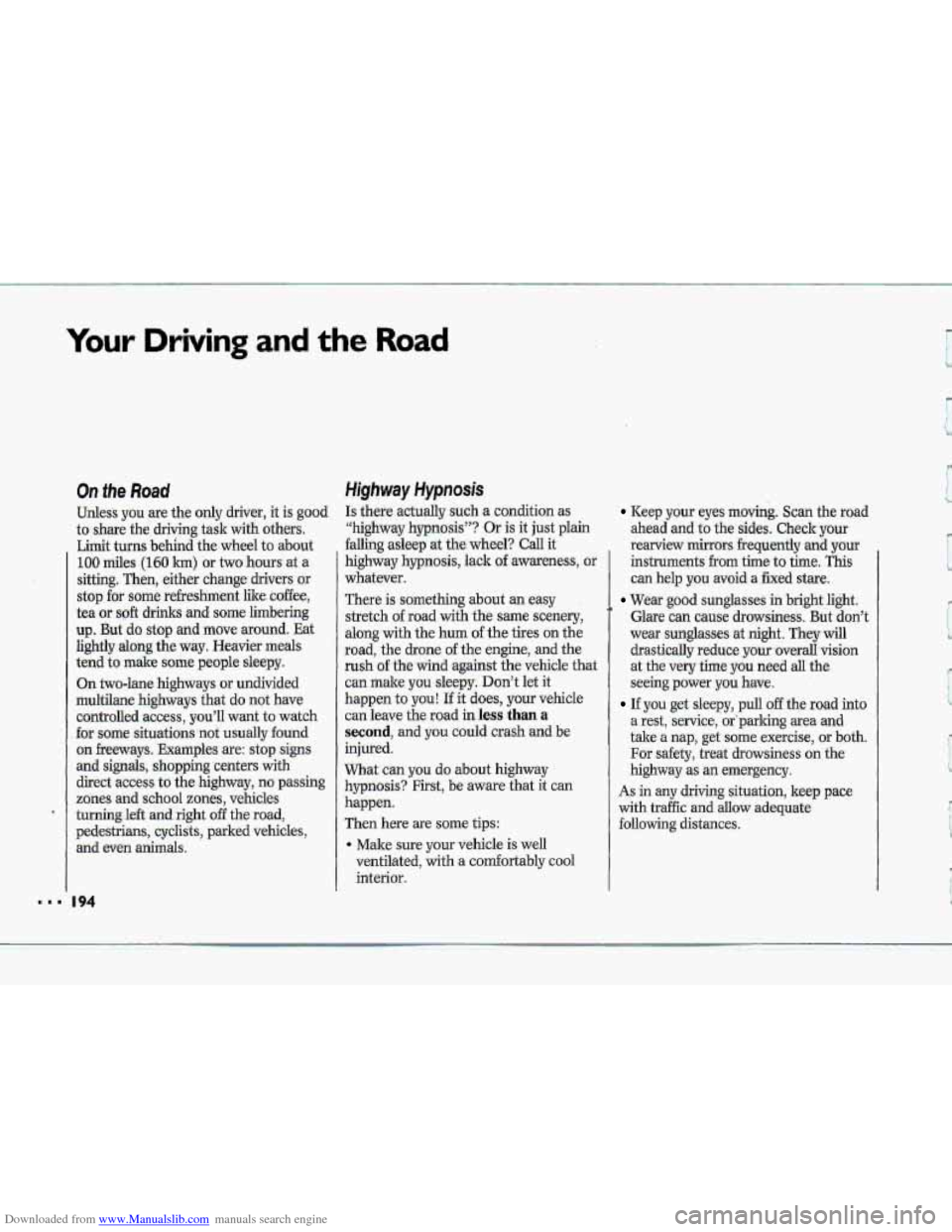
Downloaded from www.Manualslib.com manuals search engine Your Driving and the Road
On She Road
Uidess you are the -only driver, it is good
to share the driving task with others.
Limit turns behind
the wheel to about
100 miles (160 km) Or two hours at a
sitting.-Then, either change drivers ar
stop for some rdreshment like coffee,
tea or
soft drinks and some limbering
up.
But do stop and move around. Eat
lightly along the way. Heavier meals
tend to
mdke some people sleepy.
On two-lane highways or
undivided
multilane highways that do not have
controlled .access,.you’ll
wmt to watch
for some situations :not usustlly found
on freeways. Examples: are: stop signs
and signals, shopping tenters with
direct access
to the highway, no passing
zones and school zones, vehicles
turning
le& and- right off the-road,
pedestrians, cyclists, parked vehicles, and even a&&.
Highway Hypnosis
Is thete-actually such a condition as
“highway hypnosis”? Or
is it just plain
falling asleep at the wheel? Call it
highway hypnosis, lack
of awareness, or
whatever.
There is
something about an easy
stretch
of road with the same scenery,
along with the
hum of the tires on the
road, the drone of the engine; and the
rush of the wind against the vehicle that
can make you sleepy. Don’t let it
happen
to you! If it does, your vehicle
can leave the road in less than a
second, and you could crash and be
injured.
What can you do about highway
hypnosis? First, be aware that it can
happen.
Then here
are some tips:
4 Make sure your vehicle is well
ventilated,
with a comfortably cool
interior.
Keep your eyes moving. Sca.n the road
ahead and
-to the sides. Check your
rearview mirrors frequently and your
instruments from time to time. This
can help you avoid
a fixed stare.
Wear good sunglasses in bright light.
Glare can cause drowsiness. But
don’t
wear sunglasses at night. They will.
drastically reduce-your,overall.~sion
at the very time you need all the.
seeing power
you have.
If you get sleepy, pull off the road into
a rest, service, &‘parking area and
take a nap, get so.me exercise, or both.
For safety, treat drowsiness on the
highway
as an emergency.
As in any driving situation, keep pace
with traffic and allow adequate
foIlowing distances.
Page 209 of 370
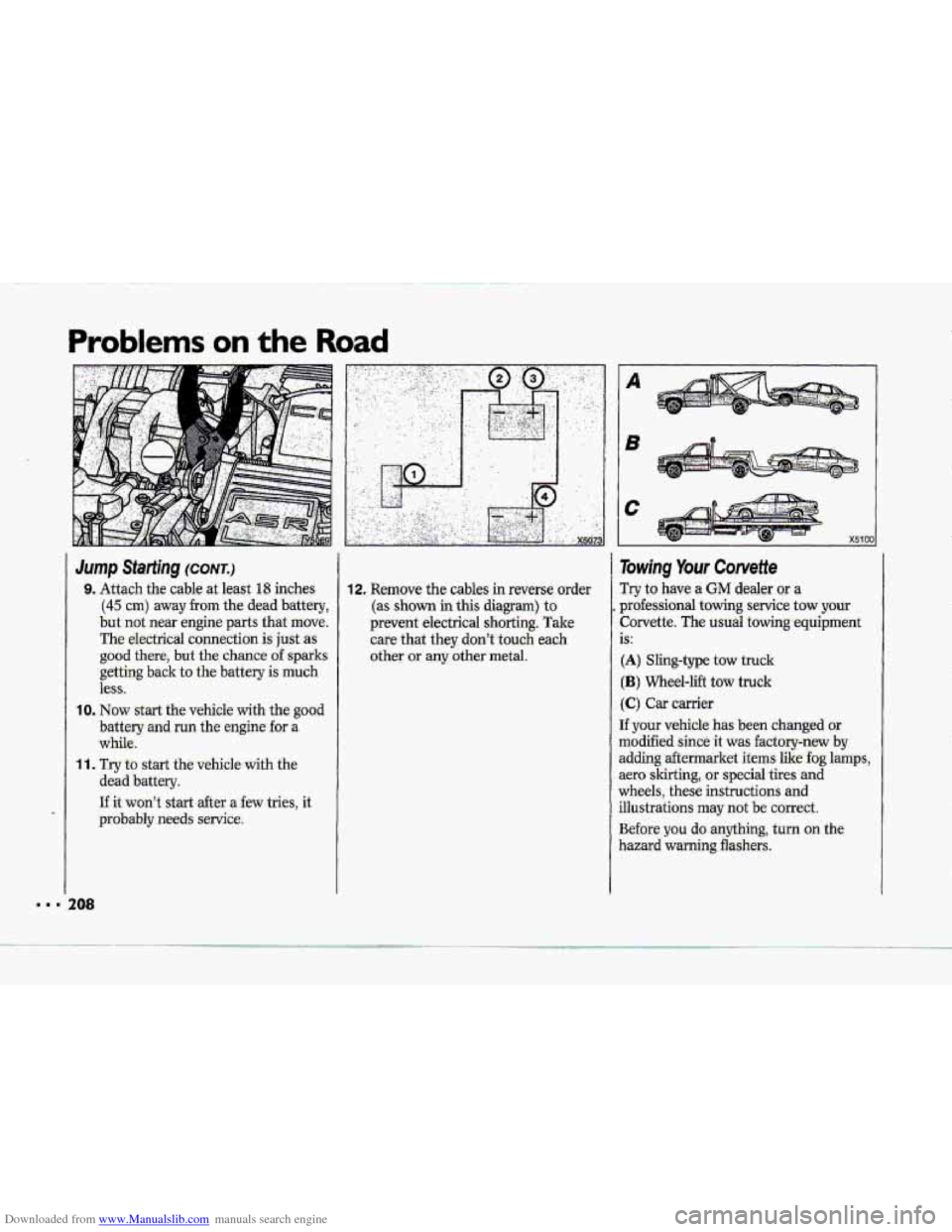
Downloaded from www.Manualslib.com manuals search engine Problems on the Road
Jump Siaithg (C0;NT.)
9. Attach the cable at least 18 inches
(45 em> away from the dead battery,
but -not near engine
parts that move.
The dectrical cowection is just as
good there, but the chance of sparks
getting back to., the batt-ery is much
less.
10. Now start the vehicle with the go0.d
battery and run the engine
for a
while.
11. Try’to start the vehicle with the
dead battery.
If it won’t start after a>few tries, it
probably needs service.
108
12, Remove the cables in reverse order
(as shown in this diagram) to
prevent electrical shorting. Take
care that they don’ttouch each
other or any other m&al.
Towing Your Corvette
Try to have a GM dealer or a
professional towing service tow your
Corvette, The usual towing equipment
is
:
(A) Sling-twe tow truck
(B) Wheel-lift tow truck
(C) Car carrier
If your vehicle has-been changed or
modified since it was factory-new by
adding aftermarket items like fog lamps,
aero skirting, or special-tires and
wheels, these instructions and
illustrations may not be correct.
Before
you do anything, turn on the
hazard warning
flashers.
Page 225 of 370
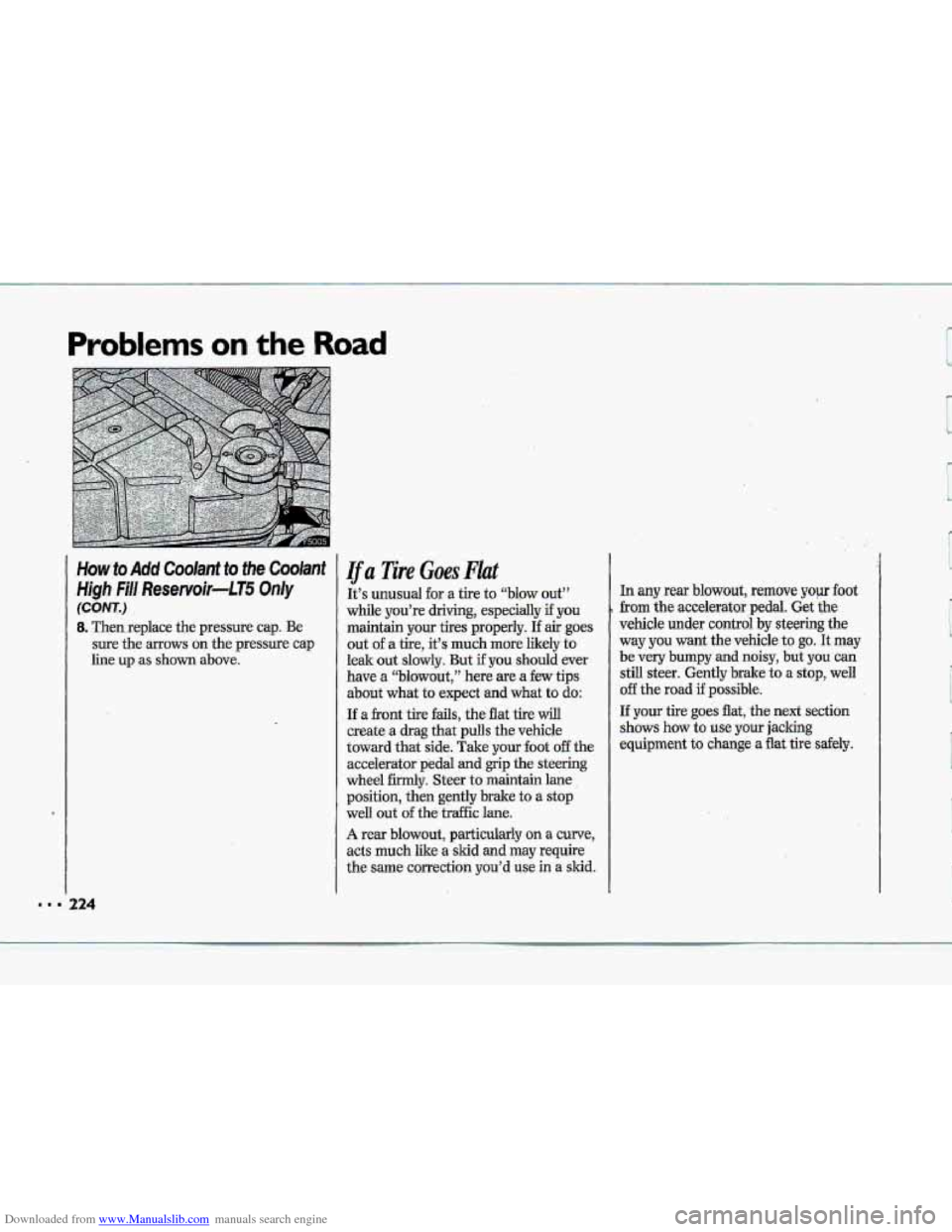
Downloaded from www.Manualslib.com manuals search engine Problems on the Road
lJu Tire Goes Flat
It’s unusual for a tire to “blow out”
while you’re driving, especially if-you
maintain
your tires properly. If air goes
out of a tire, it’s much more likely to
leak out
slowly. But if you should ever
have a “blowout,” here are a few tips-
about what to expect
and what to do:
If a front tire fails, the flat tire will
create a drag that pulls the vehicle
toward that side. Take yuur foot 08 the
accelerator pedal
and grip the steering
wheel firmly. Steer to maintain lane
p-osition, then gently brake to -a stop
well out of the. traffic lam.
A rear blowout, particularly on a curve,
acts much like a skid and may require
the
same corre&ion you’d use in a skid.
h any rear bhwout, remove yop foot
from the accelerator pedal. Get the
vehicle under control by steering the
way you want the vehicbto go. It may
be very bumpy and noisy, hut you can
still steer. Gently brake to B stop, well
off’ the road if posiible.
If your tire go& flat, the next section
shows how to use your jacking
equipment to change a flat tire sdely.
e